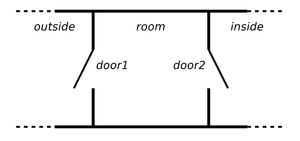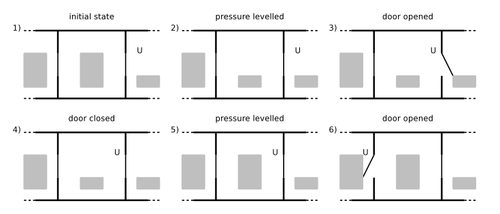Modularisation Plug-in Tutorial: Difference between revisions
imported>Alexili mNo edit summary |
imported>Mathieu |
||
| (3 intermediate revisions by 2 users not shown) | |||
| Line 1: | Line 1: | ||
Go to the [[Modularisation Plug-in|plug-in description page]]. | Go to the [[Modularisation Plug-in|plug-in description page]]. | ||
| Line 127: | Line 126: | ||
VARIABLES door error | VARIABLES door error | ||
INVARIANTS | INVARIANTS | ||
@inv1 door ∈ BOOL | |||
@inv2 error ∈ BOOL | |||
OPERATIONS | OPERATIONS | ||
operation for opening a door | operation for opening a door | ||
open ≙ | open ≙ PRE | ||
@pre1: door = FALSE | |||
@pre2: error = FALSE | |||
RETURN error_status | |||
POST | |||
@post1: door' = TRUE | |||
@post2: error' ∈ BOOL | |||
@post3: error_status' = error' | |||
END | |||
operation for closing a door | operation for closing a door | ||
close ≙ | close ≙ PRE | ||
@pre1: door = TRUE | |||
@pre1: error = FALSE | |||
RETURN error_status | |||
POST | |||
@post1: door' = FALSE | |||
@post2: error' ∈ BOOL | |||
@post3: error_status' = error' | |||
END | |||
END | END | ||
| Line 208: | Line 207: | ||
There is, however, also a additional proof obligation that requires to demonstrate that a call to ''d1_open'' was done in a state satisfying the operation preconditions. This is the reason we are required to add ''d1_error = FALSE'' into the event guard. | There is, however, also a additional proof obligation that requires to demonstrate that a call to ''d1_open'' was done in a state satisfying the operation preconditions. This is the reason we are required to add ''d1_error = FALSE'' into the event guard. | ||
[[Category:Plugin]] | |||
Latest revision as of 20:58, 10 November 2009
Go to the plug-in description page.
TODO: This tutorial document is under construction
The tutorial illustrates the use of the modularisation plug-in in an Event-B development. The example used is rather small scale but it still demonstrates some basic principles of introducing modules during the development process.
Sluice Control Example
The example is a sluice with two doors connecting areas with dramatically different pressures. The pressure difference makes it unsafe to open a door unless the pressure is leveled between the areas connected by the door. The purpose of the system is to adjust the pressure in the sluice area and control the door locks to allow a user to get safely inside to outside. Such system can be deployed, for example, on a submarine to allow divers to get out while submerged.
The system parts are two doors that can be operated independently of each other and a pressure controller that allows the change of pressure in the sluice area. The following is a schematic depiction of the system.
The system is summarised with the following set of requirements:
- the system allows a user to get inside or outside by leveling pressure between room and a destination
- the system has three locations - outside, sluice and inside
- the system has two doors - door1, connecting outside and sluice, and door2, connecting sluice and inside;
- there is a device to change pressure in sluice;
- a door may be opened only if the pressures in the locations it connects is equalised;
- at most one door is open at any moment;
- the pressure can only be switched on when the doors are closed.
Requirements 1-4 characterise the system by stating its goal and its major parts. The last three characterise the system behaviour. More precisely, they are the safety properties of the system.
The following diagram shows the stages of the system operation that let a user to get outside starting in the inside area.
The shaded rectagles denote a pressure level, high pressure area corresponds to a higher rectangle. The "u" label marks the current position of a system user. Initially, a user is inside and the sluice pressure is levelled with the outside pressure. Before the door connecting to the sluice is opened, the pressure is decreased to level it with the inside pressure. Once the door is open, the user moves in, the door is sealed again. Finally, the sluice pressure is set to match the outside pressure and the door leading may be safely opened.
Initial Model
The initial model contains three variables, one for each major system part.
variables door1 door2 pressure error
The typing is as follows:
invariants
@inv1 door1 ∈ BOOL
@inv2 door2 ∈ BOOL
@inv3 pressure ∈ {0,1}
@inv7 error ∈ BOOL
The requirement 6 that at most one door may be open at any given moment translates into the following model invariant
@inv4 error = FALSE ∧ door1 = door2 ⇒ door1 = FALSE
We also formally state the when it is safe to open a door
@inv5 error = FALSE ∧ door1 = TRUE ⇒ pressure = 0 @inv6 error = FALSE ∧ door2 = TRUE ⇒ pressure = 1
The two invariants above correspond to the 5th requirement.
The following is complete characterisation of the model events.
event INITIALISATION
then
@act1 door1 ≔ FALSE
@act2 door2 ≔ FALSE
@act3 pressure ≔ 0
@act4 error ≔ FALSE
end
event open1
where
@grd1 pressure = 0
@grd2 door1 = FALSE
@grd3 error = FALSE
then
@act1 door1 ≔ TRUE
@act2 error :∈ BOOL
end
event close1
where
@grd1 door1 = TRUE
@grd2 error = FALSE
then
@act1 door1 ≔ FALSE
@act2 error :∈ BOOL
end
event open2
where
@grd1 pressure = 1
@grd2 door2 = FALSE
@grd3 error = FALSE
then
@act1 door2 ≔ TRUE
@act2 error :∈ BOOL
end
event close2
where
@grd1 door2 = TRUE
@grd2 error = FALSE
then
@act1 door2 ≔ FALSE
@act2 error :∈ BOOL
end
event pressure_low
where
@grd1 door1 = FALSE
@grd2 door2 = FALSE
@grd3 error = FALSE
then
@act1 pressure ≔ 0
@act2 error :∈ BOOL
end
event pressure_high
where
@grd1 door1 = FALSE
@grd2 door2 = FALSE
@grd3 error = FALSE
then
@act1 pressure ≔ 1
@act2 error :∈ BOOL
end
Preparing to the first Refinement
Since the purpose of the tutorial is to demonstrate the use of modules in a development, a link to a module appears very early - in the first refinement step. The strategy here is to decompose a model in such manner that the functionality of all the major components is encapsulated in independent modules while the main development does high-level management of components.
The first module is door controller. Its interface mirrors the modelling of door behaviour in the abstract model.
INTERFACE DoorController VARIABLES door error INVARIANTS @inv1 door ∈ BOOL @inv2 error ∈ BOOL OPERATIONS
operation for opening a door
open ≙ PRE @pre1: door = FALSE @pre2: error = FALSE RETURN error_status POST @post1: door' = TRUE @post2: error' ∈ BOOL @post3: error_status' = error' END
operation for closing a door
close ≙ PRE @pre1: door = TRUE @pre1: error = FALSE RETURN error_status POST @post1: door' = FALSE @post2: error' ∈ BOOL @post3: error_status' = error' END END
According to the interface above, a door is characterised by its current state door that correspond to door being shut or open, and error flag denoting whether the door controller has experienced a failure.
First Refinement
In the first refinement we remove the modelling of doors from the main model and start relying on the module which interface we have just described (with an assumption the interface would be implemented later).
As there are two doors in the system, the door controller module is imported twice. To distinguish between the variables, constants and operations of the two modules, a user provides a module prefix.
uses @d1 DoorController uses @d2 DoorController
This refinement step removes abstract variables door1 and door2 by replacing them with corresponding variables of imported modules.
variables pressure error
invariants @inv1 door1 = d1_door @inv2 door2 = d2_door @inv4 d1_error = TRUE ∨ d2_error = TRUE ⇒ error = TRUE
This is how door-related events are refined.
event open1 refines open1
where
@grd1 pressure = 0
@grd2 d1_door = FALSE
@grd3 error = FALSE ∧ d1_error = FALSE
then
@act1 error ≔ d1_open
end
In error ≔ d1_open, d1_open is an operation call modelling the opening of the first door. The case of closing a door is similar.
event close1 refines close1
where
@grd1 d1_door = TRUE
@grd2 error = FALSE ∧ d1_error = FALSE
then
@act1 error ≔ d1_close
end
Let us see what it means to call d1_open in event open1. Similar to the VDM approach, 'd1_open is merely a reference standing for the conjunction of post-conditions of operation open from module d1. Expanding d1_open using the interface definition, we get the following event:
event open1 refines open1
where
@grd1 pressure = 0
@grd2 d1_door = FALSE
@grd3 error = FALSE ∧ d1_error = FALSE
then
@act1 error :∈ BOOL
@act2 d1_door ≔ TRUE
end
There is, however, also a additional proof obligation that requires to demonstrate that a call to d1_open was done in a state satisfying the operation preconditions. This is the reason we are required to add d1_error = FALSE into the event guard.

